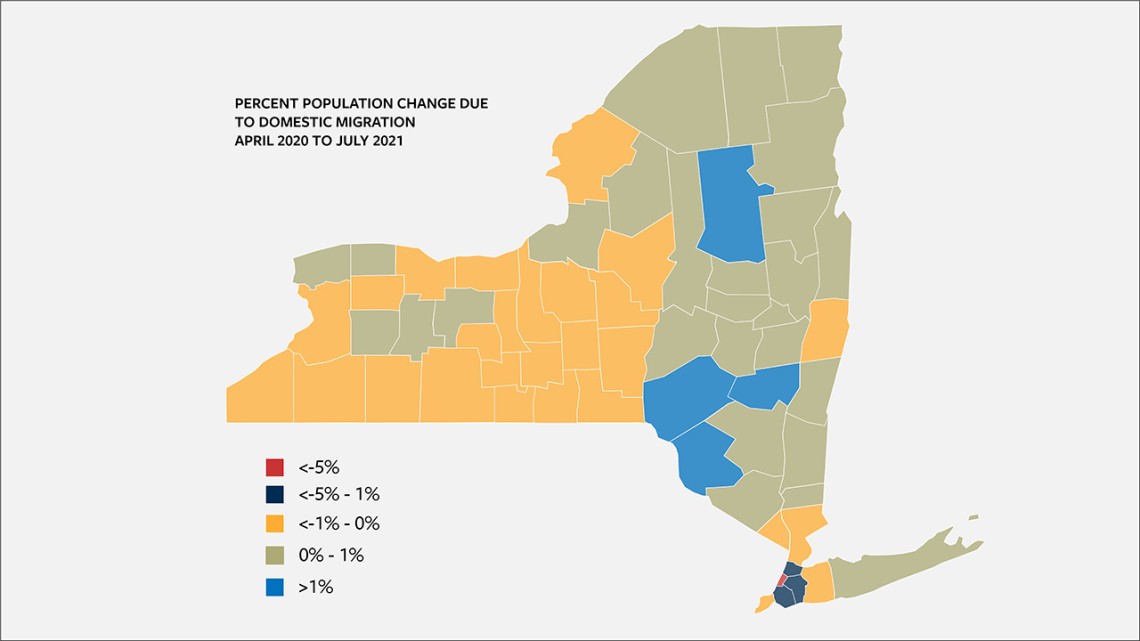
Map showing New York state counties that gained or lost population due to domestic migration – more people moving in than out within the U.S. – from April 2020 to July 2021.
Pandemic prompted exodus from New York City, gains upstate
By James Dean
New York City’s population plunged by nearly 4% – more than 336,000 people – during the pandemic’s first year as residents migrated to less dense areas in nearby counties and neighboring states, according to a Cornell analysis of U.S. Census Bureau data released March 24.
The outflow of city residents resulted in some upstate New York counties gaining population or stemming losses compared to previous census estimates, shows the analysis by the Program on Applied Demographics, part of the Cornell Jeb E. Brooks School of Public Policy.
The report provides the public and state officials the first look at how the coronavirus pandemic’s onset in March 2020 – when New York City emerged as ground zero in the U.S. – influenced populations in each of New York state’s 62 counties and 10 economic development regions, at least temporarily.
The census estimates confirm what many upstate residents knew: More of their neighbors are former Big Apple residents.
“For a long time, a lot of upstate New York counties saw more people leaving the county than arriving,” said Jan Vink, chief demographer at the Program on Applied Demographics. “This time, many more counties saw more people coming in than moving out – with the big exception of New York City, which saw its populations drop like never seen before.”
Overall, between April 1, 2020, when the last census estimates were released, and July 1, 2021, New York state lost more than 365,000 people, or 1.8% of its population, dropping below 20 million residents.
The new analysis quantifies how the population in each county and region shifted during that period based on the number of births and deaths, and on how many people moved in or out within the U.S. or internationally. Highlights include:
- Sixteen counties and two economic development regions – Capital and Mid-Hudson – saw population gains, while 46 counties and eight regions experienced declines.
- Losses in those eight regions due to domestic migration – more people leaving for other parts of the country than arriving – were smaller than in previous census estimates. More people moved into than moved out of 26 counties, up from just six counties in 2018-19.
- Sullivan County was the state’s fastest growing at a rate of 1.5%. Orange County had the largest numerical gain, adding 3,215 people.
- New York City accounted for the four steepest population drops, led by Manhattan (New York County), which shed 117,275 residents – nearly 7%. Brooklyn (Kings County) followed with a loss of 95,022 people, while Queens and the Bronx declined by 74,321 and 47,706 people, respectively.
- After New York City’s overall 3.8% population decline, the Southern Tier region – home to Cornell’s Ithaca campus in Tompkins County – experienced the second-largest percentage decrease of 0.8%, likely influenced by colleges and universities shifting to virtual instruction.
- All regions saw deaths rise and births fall. Demographers attribute the increased deaths to COVID-19, Vink said, while speculating that families delayed pregnancies amid the pandemic’s uncertainty.
- While several hundred thousand people moved away, New York City – led by Brooklyn – recorded more than 38,000 more births than deaths, contributing to the state’s 0.1% “natural increase” in population.
- Only 10 counties had more births than deaths, mostly in the New York City area. Erie County suffered the biggest natural decrease due to more deaths – 2,753 people.
The migration away from New York City into less populated areas from April 2020 to July 2021 is consistent with flows seen across the Northeast, according to the Program on Applied Demographics. The census data, which is subject to revision, does not yet include demographic detail about the people who moved.
With pandemic protocols now easing in many places, but continued uncertainty about coronavirus variants, it’s unknown if the dramatic population shift initiated two years ago in New York City and its ripple effects will be lasting.
“Will those people that moved out of the city return?” Vink said. “There are some signs that many are returning, that the moves were temporary. It will be very interesting to see.”
Get Cornell news delivered right to your inbox.
Subscribe

